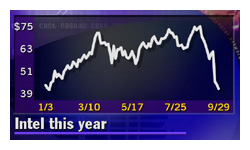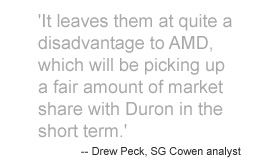|
Intel scraps 'Timna'
|
 |
September 29, 2000: 2:18 p.m. ET
After several delays, company abandons low-cost-processor plans
By Staff Writer Richard Richtmyer
|
NEW YORK (CNNfn) - After more than a year-and-a-half in the making, Intel has scrapped plans to develop the ultra-low-cost PC microprocessor it had code-named "Timna."
Because of technical problems and weakening demand for low-end PCs, Intel decided to cease the development of the Timna, which had been intended for PCs priced below $600, according to Intel spokesman Michael Sullivan.
 The Timna chips had at first been expected to hit the market in the second half of this year. However, Intel had originally designed the Timna to work with high-speed memory systems based on technology from Rambus. The Timna chips had at first been expected to hit the market in the second half of this year. However, Intel had originally designed the Timna to work with high-speed memory systems based on technology from Rambus.
Earlier this year, when Rambus-based memory systems did not come down in price as quickly as Intel had anticipated, the company began a redesign to enable the Timna to work with conventional memory systems and pushed the planned rollout to the first quarter of next year.
"We had gotten to the stage where we would need to do one additional change to the memory translator in order for the Timna to come to market," Sullivan said. "That would have meant about a month's delay, and as a result of that, we would really be missing the introduction window for our customers who wanted to use the product right away."
 The idea behind Timna was relatively simple. By including functions that previously had required separate chips -- such as graphics and memory control -- on the same piece of silicon as the processor, the new chips would enable PC makers to reduce their overall manufacturing costs. The idea behind Timna was relatively simple. By including functions that previously had required separate chips -- such as graphics and memory control -- on the same piece of silicon as the processor, the new chips would enable PC makers to reduce their overall manufacturing costs.
Another reason behind Intel's decision to kill the Timna project is that PC makers trying to achieve lower pricing have been able to do so using Intel's Celeron processor, according to Sullivan.
"They are able to get to those price points, if they wish, with Celeron processors, and other components in the PC have also come down in cost," he said.
A question of price versus performance
Intel also decided that there is not the same degree of consumer interest in ever-lower PC price points as there had been when the company first came up with the Timna plan, according to Sullivan.
"People seem to be valuing performance more," he said.
But some market observers said that Intel's approach to achieving lower costs with Timna undercut its ability to compete in the lower end, where consumers don't want to sacrifice performance for lower prices.
"Integrating graphics with the processor compromises performance of the graphics," said Drew Peck, semiconductor analyst at SG Cowen. "The problem isn't that people aren't interested in the low-end PCs selling at $600, it's that people aren't interested in processors whose performance is compromised because the graphics is built in."
 In the short term, Intel's decision to forgo Timna bodes well for Advanced Micro Devices, its chief rival in the market for PC processors, Peck said. In the short term, Intel's decision to forgo Timna bodes well for Advanced Micro Devices, its chief rival in the market for PC processors, Peck said.
Over the past year, AMD has become an increasingly become a competitor with its high-end "Athlon" and low-end "Duron" microprocessors. During the second quarter, Athlon and Duron sold a combined 1.8 million units, a 52 percent increase from the first quarter.
"It leaves them at quite a disadvantage to AMD, which will be picking up a fair amount of market share with Duron in the short term," Peck said.
Moving ahead, however, Intel's decision to back out of Timna may hurt both companies as they become more aggressive on pricing for low-end processors. With PC demand already weakening, Peck said the move will accelerate an inevitable pricing plunge that was going to come about next year anyway.
 "I suspect all that will do is to exacerbate processor pricing, and we're going to see the Pentium III quickly fall down to compete in pricing in the $500-$800 space," he said. "In the longer term, pricing gets crushed on all processors, including AMDs." "I suspect all that will do is to exacerbate processor pricing, and we're going to see the Pentium III quickly fall down to compete in pricing in the $500-$800 space," he said. "In the longer term, pricing gets crushed on all processors, including AMDs."
Intel (INTC: Research, Estimates) shares were off $2.38, or 5.3 percent, at $42.06 in mid-afternoon trade. The company's stock has been under a lot of pressure since it issued a warning last week that its third-quarter revenue growth would be much lower than Wall Street had expected.
Meanwhile, shares of AMD (AMD: Research, Estimates) were trading 50 cents higher at $24.12, a 2.1 percent gain. 
|
|
|
|
|
 |

|

